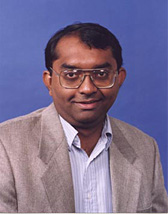Joint CS/ECE Seminar
An Overview of Radio Spectrum Co-Existence Research at FUNLAB
Prof. Sumit Roy
 Monday, 4/10/17, 11:00am
Monday, 4/10/17, 11:00am
New Computer Science room 120
Abstract: This talk will present an overview of current research projects that thematically center around RF spectrum sharing – a topic whose importance has been ratcheted by the Jun 2010 Presidential Memorandum to ``make available a total of 500 MHz of Federal and nonfederal spectrum over the next 10 years, suitable for both mobile and fixed wireless broadband use”. The first down payment on the above is the current AWS-3 transition of 50 MHz of spectrum that will require spectral coordination between numerous Federal incumbents (radar, navigation etc.) and cellular operator networks (notably, 4G LTE and WiFi). We will describe two projects.
Radio Mapping using Wide Area RF Software Defined Radio/Sensors
The need for more efficient spectrum use has led to notion of Dynamic Spectrum Access (DSA) whereby secondary (unlicensed) users are permitted to use some bands on a `non-interfering’ basis with the primary (licensed) users (e.g. TV White Spaces). This in turn has resulted in database centric architectural solutions (to ensure the desired ‘non-interference’) with the recognition that wide-area distributed spectrum sensing using fixed (and in future mobile crowdsourced) spectrum sensors could be an integral component of such systems. The talk will describe recent work.
Link Layer Enablers for Spectral Co-existence: Radar/Wi-Fi & LTE
Effective spectrum sharing will rely on new ideas and effective tools for modeling and analysis of spectral co-existence between dissimilar systems. We have developed a suite of analytical and simulation approaches to explore co-existence between co-located Federal (e.g various types of radars) and civilian communication systems, at both the link and network levels. These include, necessarily balancing two conflicting goals: ensuring that the cumulative impact of civilian communication technologies (such as cellular LTE and WiFi networks) fall within incumbent protection guidelines as required, while simultaneously quantifying the impact of radar interference on such network throughput. This talk will describe some recent results on link layer co-existence mechanisms between a search radar and Wi-Fi networks.
Bio: Sumit Roy is Integrated Systems Professor of Electrical Engineering, Univ. of Washington where his research interests include fundamental analysis/design of wireless communication and sensor network systems spanning a diversity of technologies and system application areas: next-gen wireless LANs and beyond 4G cellular networks, heterogeneous network coexistence, spectrum sharing, white space networking and software defined radio platforms, vehicular and underwater networks, smart grids and RFID sensor networking. He has served as Associate Editor for all the major ComSoc publications in his area at various times, including the IEEE Trans. Communications and IEEE Trans. on Wireless Communications. He was elevated to IEEE Fellow by Communications Society in 2007 for "contributions to multi-user communications theory and cross-layer design of wireless networking standards”.
